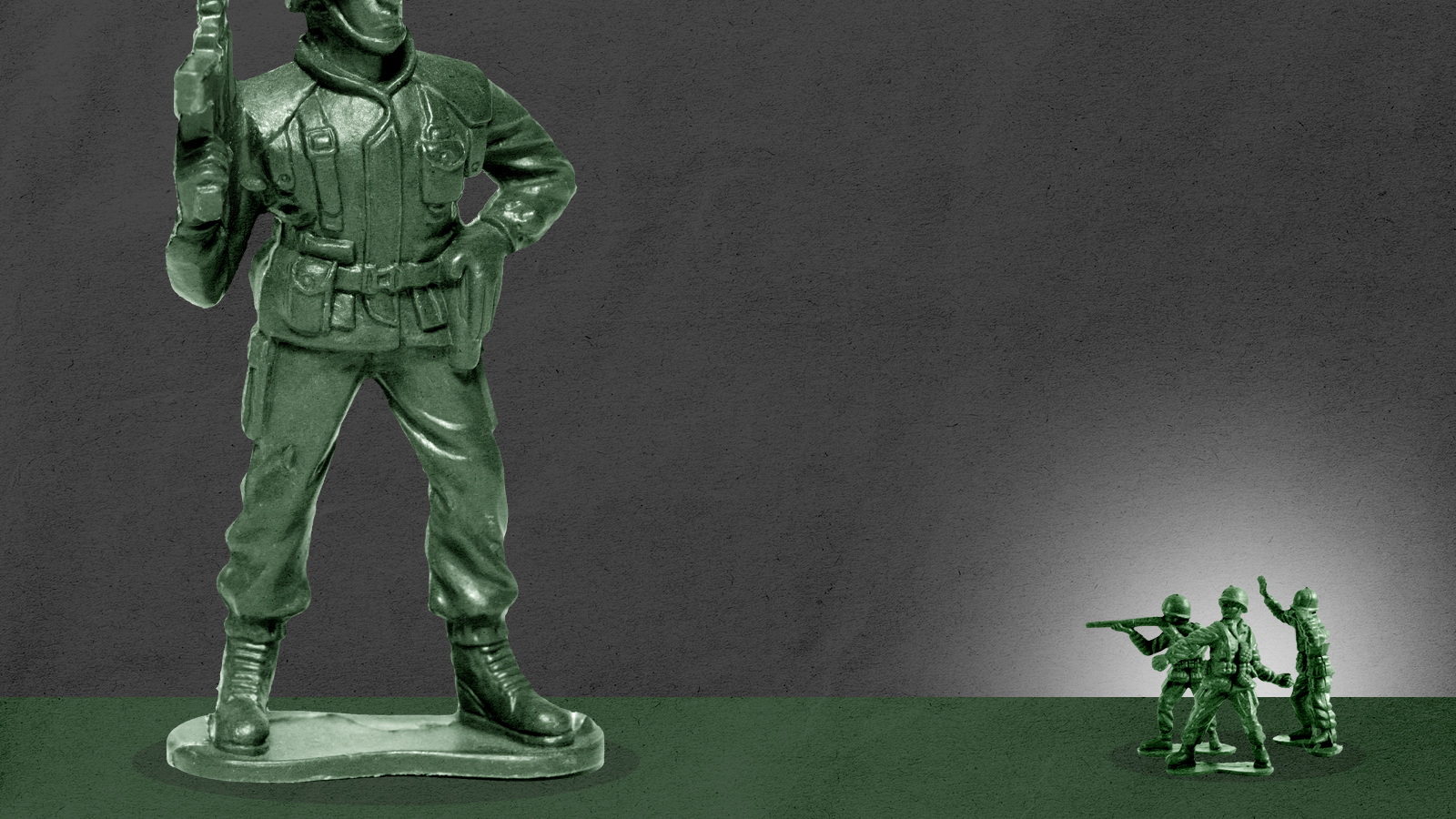Does Ukraine have the 4 factors that go into a successful insurgency?
Lessons from history both near and far


The Russian war against Ukraine has so far been fought largely between trained soldiers on both sides, and with tanks, planes, and artillery. But according to many experts, that's not where this conflict is headed. Russia's military is just too powerful, and Ukraine's conventional forces too small, despite high morale.
So, what comes next?
It seems likely that Ukrainians aren't going to surrender and allow themselves to become part of Russia, or whatever it is that Vladimir Putin has in mind. Instead, there is the possibility of an insurgency.
The Week
Escape your echo chamber. Get the facts behind the news, plus analysis from multiple perspectives.

Sign up for The Week's Free Newsletters
From our morning news briefing to a weekly Good News Newsletter, get the best of The Week delivered directly to your inbox.
From our morning news briefing to a weekly Good News Newsletter, get the best of The Week delivered directly to your inbox.
The dictionary defines an insurgency as "a condition of revolt against a government that is less than an organized revolution and that is not recognized as belligerency." Think of the French insurgents in World War II, whose fight against the Germans is famed and widely considered successful. But the French rebels never held territory and the actions they took led to harsh reprisals against the citizens they intended to liberate; it was the Allies landing on the beaches of Normandy and the fighting that followed, rather, that was definitive in returning France to the French, according to more recent historians.
There are many reasons why insurgencies succeed or fail, but here are four elements shared by most successful insurgencies:
Strong leadership
Some of the names are recent and familiar to us today, like Mullah Omar, leader of the Taliban in Afghanistan during most of the American war. Even though he died a few years before the final victory, the broader leadership he was a part of is in control of the country right now.
There was also strong leadership when the Soviets lost their war in Afghanistan (1979-1989), with warlords like Ahmad Shah Massoud and Abdul Rashid Dostum leading the way with tactical smarts, brutality, and a certain charisma.
A free daily email with the biggest news stories of the day – and the best features from TheWeek.com
Outside help
One thing that's hard to dispute is that successful insurgencies require outside help.
You can call what happened in Haiti in 1793 a successful slave revolt (which it was), but it was also a successful insurgency against an entrenched foe. Resources for the rebels — mostly former slaves — were extremely limited, but luckily for the fighters, the French who controlled Haiti had enemies. The British and Spanish supplied training, weapons, food, and other supplies to the insurgents, all of which had an impact on the war.
In Vietnam, likewise, the Viet Cong had an entire Ho Chi Minh Trail through the mountains and jungles to supply them, while the North Vietnamese had key material help from the Soviet Union. And in the Afghan war against the Soviets, the mujahideen — Islamic fighters backed by the United States — were famously given Stinger missiles that had a huge impact by bringing down Soviet helicopter gunships that dominated the skies.
Rough terrain
All insurgencies need such places to retreat, lick wounds, build strength, and get resupplied.
When the Arabs rose up against the Turks during World War I, one of their great advantages was being able to melt away into the deserts after attacks. They knew the ground; they knew where to find the basics they needed to survive, and they could blend into the local population. Turkish reprisals against ordinary Arabs further inflamed the situation and ended up making life harder for the Turkish overlords.
Similarly, the jungles of Vietnam were impassible and unknowable to U.S. servicemen, especially on relatively short tours in country that meant that people who learned the territory were soon rotated out. The same was true of U.S. soldiers in Afghanistan. Troops — and officers — who learned the territory and the people, were quickly replaced by people who had to start the whole process over again.
Similarly, the Chechens who fought Russia did so on their own ground. The Caucasus nation is mountainous and wild. It was only by resorting to brutal tactics that led to depopulation of some areas that the Russians were finally able to bring the region under control, and even then, they needed to put a local, brutal strongman in charge to keep order.
A foe with limits
But strong leadership alone won't get you very far, no matter how famed your commander might be. The Roman general and eventual dictator Julius Caesar conquered Gaul (modern France) over the course of about eight years, beginning in 58 B.C. During much of that time, he faced off with the wily and charismatic Vercingetorix, who made Caesar's life hell.
But eventually, despite Vercingetorix's ability to keep fractious tribes united, knowledge of the local terrain, and love of his people, he lost against Caesar's willingness to ruthlessly kill and enslave everyone who stood against him. Of the approximately 3 million people living in pre-Roman Gaul, 1 million were killed and another million were enslaved.
There is no fighting against that.
The Nazi war plan was similar. When people think of the Holocaust, they usually think of Auschwitz-Birkenau and gas chambers. Millions of Jews died that way. But more than a million others were killed by bullets. Babyn Yar, in Ukraine, is one place where it happened on an unimaginable scale — 33,000 men, women, and children.
Not only Jews were singled out for such treatment; whole villages of Christian Poles, Ukrainians, Russians, and others, were also wiped out because of the same rationale: Leave potential insurgents behind the German front lines, and they will rise up and cause trouble.
So what does all this mean for the insurgency in Ukraine?
The country has several of the advantages needed for a successful insurgency, according to history.
It has a strong leader in Volodymyr Zelensky. He is approaching legendary status in these early days of the war for both his bravery and eloquence.
It has outside help, too, coming from the U.S. and many other nations, both in terms of economic sanctions and weaponry. Weapons so far include anti-tank rockets and even fighter jets. The prospect of direct military intervention remains remote at this time.
Ukraine's territory is muddy in spring, bogging down tanks and other heavy Russian equipment. But it is not particularly mountainous, and forests only occupy 15 percent of the nation. There's also no desert to speak of, all making a successful insurgency more difficult.
Finally, there is the question of just how far the Russians are willing to go in terms of killing.
And that we simply don't know.
Jason Fields is a writer, editor, podcaster, and photographer who has worked at Reuters, The New York Times, The Associated Press, and The Washington Post. He hosts the Angry Planet podcast and is the author of the historical mystery "Death in Twilight."
-
 7 bars with comforting cocktails and great hospitality
7 bars with comforting cocktails and great hospitalitythe week recommends Winter is a fine time for going out and drinking up
-
 7 recipes that meet you wherever you are during winter
7 recipes that meet you wherever you are during winterthe week recommends Low-key January and decadent holiday eating are all accounted for
-
 Nine best TV shows of the year
Nine best TV shows of the yearThe Week Recommends From Adolescence to Amandaland
-
 US offers Ukraine NATO-like security pact, with caveats
US offers Ukraine NATO-like security pact, with caveatsSpeed Read The Trump administration has offered Ukraine security guarantees similar to those it would receive from NATO
-
 How Bulgaria’s government fell amid mass protests
How Bulgaria’s government fell amid mass protestsThe Explainer The country’s prime minister resigned as part of the fallout
-
 Pushing for peace: is Trump appeasing Moscow?
Pushing for peace: is Trump appeasing Moscow?In Depth European leaders succeeded in bringing themselves in from the cold and softening Moscow’s terms, but Kyiv still faces an unenviable choice
-
 Femicide: Italy’s newest crime
Femicide: Italy’s newest crimeThe Explainer Landmark law to criminalise murder of a woman as an ‘act of hatred’ or ‘subjugation’ but critics say Italy is still deeply patriarchal
-
 Brazil’s Bolsonaro behind bars after appeals run out
Brazil’s Bolsonaro behind bars after appeals run outSpeed Read He will serve 27 years in prison
-
 The $100mn scandal undermining Volodymyr Zelenskyy
The $100mn scandal undermining Volodymyr ZelenskyyIn the Spotlight As Russia continues to vent its military aggression on Ukraine, ‘corruption scandals are weakening the domestic front’
-
 Americans traveling abroad face renewed criticism in the Trump era
Americans traveling abroad face renewed criticism in the Trump eraThe Explainer Some of Trump’s behavior has Americans being questioned
-
 Nigeria confused by Trump invasion threat
Nigeria confused by Trump invasion threatSpeed Read Trump has claimed the country is persecuting Christians
